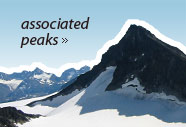Scandinavian Mountains over 2000 metres - James Baxter
Areas › Knutshols Tjønnhols Massif › Vestre Leirungstind › Alternative Routes
Vestre Leirungstind has a number of interesting routes on it due to alpine nature. Two of the three main ridges require climbing techniques to ascend them. The east ridge from the saddle with Austre Leirungstind is the most difficult and involves a pitch at grad 1V. Apparently this pitch is best tackled on the south side of the arête. This ridge is part of the classic traverse from Tjønnholstind to Knutsholstind, and being unavoidable, is probably the crux of the traverse. The west ridge is easily ascended from the saddle between Vestre Leirungstind and the spectacular Søre Knutsholstind. This is the easiest route but is hardly a classic as it involves 750 metres of slogging up scree in a gully. It is however, the safest route and as such I have described it below in detail as the recommended route.
 The final ridge is the south ridge and it is a classic with some advanced scrambling to grade III. This route is only suitable for dry conditions but offer a far better, but more exposed alternative to the scree slog of the north ridge. The route begins at the west end of Øvre Leirungstjønnin lake, 1678m, by Svartdalsbandet saddle. This saddle offers some camping spots, but is also easily reached from Torfinnsbu lodge in 2 ½ hours. From the lake head straight onto the ridge and ascend largely bare rock up to the shoulder at about 2000m elevation.
The final ridge is the south ridge and it is a classic with some advanced scrambling to grade III. This route is only suitable for dry conditions but offer a far better, but more exposed alternative to the scree slog of the north ridge. The route begins at the west end of Øvre Leirungstjønnin lake, 1678m, by Svartdalsbandet saddle. This saddle offers some camping spots, but is also easily reached from Torfinnsbu lodge in 2 ½ hours. From the lake head straight onto the ridge and ascend largely bare rock up to the shoulder at about 2000m elevation.
The ascent, which is quite steep in places up to the shoulder, is unproblematic and very enjoyable. From this shoulder the ridge becomes sharper but the incline initially levels off. At the end of this more level section the ridge steepens considerably and leads to a small tower, followed by an exposed arête and second tower before dropping to a small saddle, which is no more than a notch.
From the base of the first tower to the notch after the second tower there is a considerable amount of exposed and challenging scrambling, if not climbing. This can be avoided by veering to the west of the ridge beyond the end of the more level section atop the shoulder, but well before the first tower. Traverse north westwards across boulders and a couple of spurs, taking care not to go too high, for a ½ km until you reach a broad boulder filled gully. Ascend this wide gully right to the top. For roughly last 50 metres of the gully narrows considerably and bears east (right). It also becomes slightly steeper and quite loose as it approaches the main south ridge again, which it reaches at the afore mentioned notch, above the second tower.
From this notch the route ahead looks very severe as vertical slabs rise up to the summit. However, the route now climbs only a few metres towards these slabs before traversing to the west for about 25 metres along a shelf. When the shelf ends ascend an 7-8 metre slab, which is somewhat exposed, to gain a higher shelf. Again follow this higher shelf west for roughly 25 metres and it will lead you to the bottom of a gully. Climb you this gully for about 20 metres exiting on the west (left) side. The higher half of this gully is steep and quite demanding but not so exposed. The top of the gully exits on the north ridge and it is easy to follow the scree up for 200 metes to reach the lofty summit.
The return is by the reverse of the route described below from Torfinnsbu lodge.

